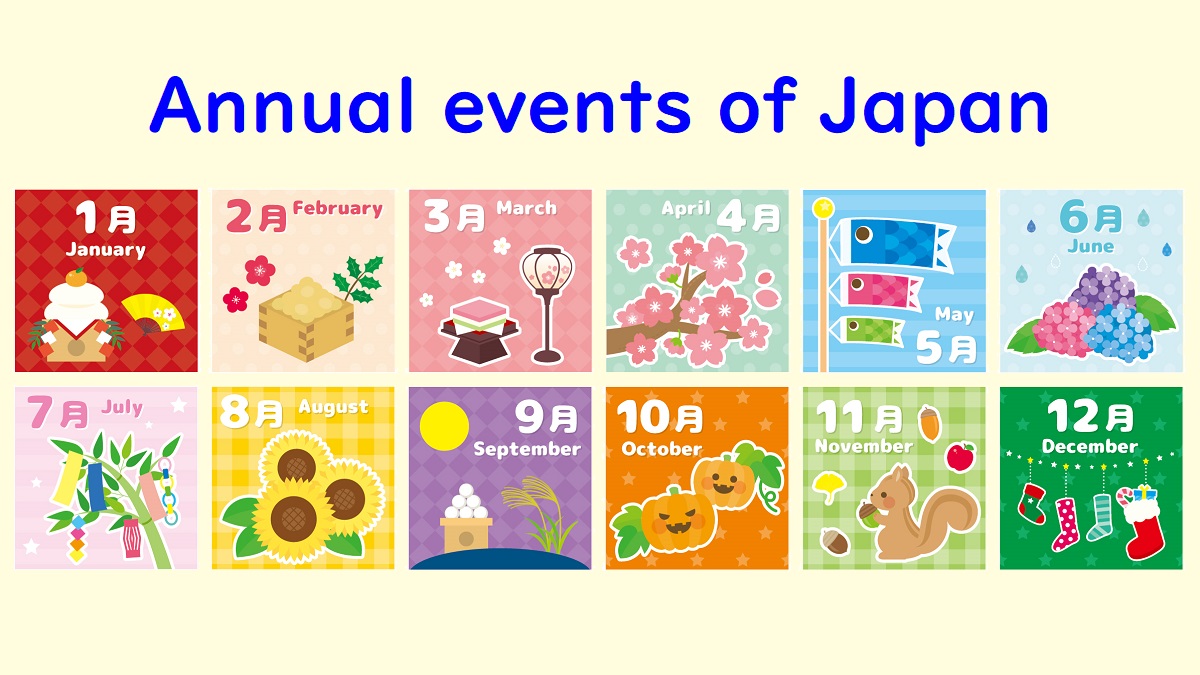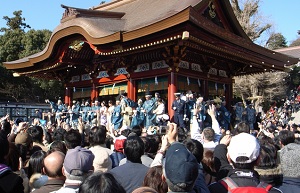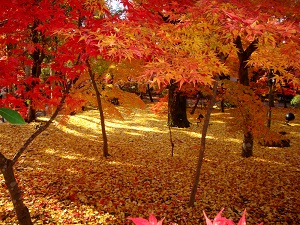Annual events of Japan
January (1-gatsu, Ichi-gatsu)
Shogatsu (January 1 to 3)
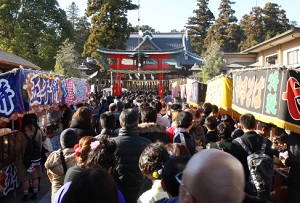
The first temple visit of the New Year
Shogatsu is the days of New Year in Japan.
It is one of the most important days for Japanese life, and all Japanese people refresh their minds in this day.
January 1st is a national holiday, and generally the first 3 days are holidays in Japan.
Most companies, public offices and shops close during these days.
For students, these days are part of the winter vacation.
Many people who live in large cities away from their families return hometown to spend these days with their families.
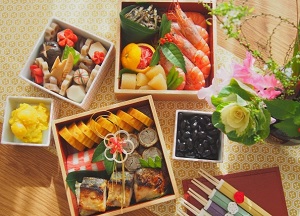
Osechi dishes for the New Year
Most Japanese people visit to a shrine or temple and pray for peace and better luck.
More than 60% of Japanese people visit there during the three days, so that is a national custom from ancient times.
Many New Year's postcards are sent from relatives and friends, so reading them is one of the enjoyments in Shogatsu.
Children are given "Otoshidama" (a small envelope filled with cash) from their parents or relatives.
So Shogatsu is a very exciting event for children.
Japanese people eat soup with mochi (rice cakes) and vegetables called "zoni" traditionally.
And a special dishes called "osechi" are served at home during Shogatsu.
Coming of Age Day (2nd Monday of January)
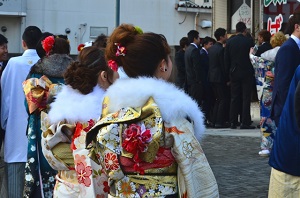
New adults in front of a ceremony hall
The second Monday of January is a national holiday called Coming of Age Day.
The 20-year-old young people are recognized as adult in this day.
(The adult age has been lowered to 18 by law amendment in 2022.)
They are allowed to drink alcohol and smoke from this age.
And, various social duties are obliged to them.
Local governments hold special ceremonies to honor them.
Many women celebrate by wearing kimono of Furisode, and some of men attende are dressed in Haori and Hakama.
February (2-gatsu, Ni-gatsu)
Setsubun (Around February 3)
Setsubun is the day about February 3rd, and it is the traditional last day of the lunar year.
The main event of the day is the bean-scattering ceremony.
This means to drive away evil spirits and bring good fortune.
People throw roasted beans around the entrances and rooms of their homes, shouting "In with fortune! Out with the demon!".
In major Buddhist temples, Bean-Throwing Ceremony are held.
Popular stars and athletes are invited and throw the beans to a crowd of people.
It is said that people should eat the same number of soybeans as their age, wishing for good health and prosperity.
National Foundation Day (February 11)
February 11 is the National Foundation Day and is a national holiday.
Unlike Independence Day of the other counties, this is not a specific historical date.
It is based on the myth that the first Emperor Jinmu ascended to the throne on February 11th in 660 B.C.
So it was decided that day was the beginning of Japan.
(Of course, it is not known whether he actually was at that period.)
Valentine's Day (February 14)
February 14 is the Valentine's Day.
This is the Western anniversary but it is a unique day in Japan.
Women present chocolates to men on this day.
There is no religious event.
In past days, women confessed their love by gifting chocolates.
But recently they present to not only important lovers but also friends, husbands or office colleagues.
It is said that chocolates of a quarter of a year are bought in this season.
The Emperor's Birthday (February 23)
February 23 is the birthday of the current Ten-no (the Emperor of Japan).
it is a national holiday.
Current Ten-no acceded to throne on May 1, 2019, so February 23 became the national holiday from 2020.
(The birthday of previous Ten-no was December 23.)
Ten-no is very special to all Japanese people and is the symbol of the nation of Japan.
But or therefore, no huge ceremony is held.
Only the public's congratulations to the Imperial Palace is held.
March (3-gatsu, San-gatsu)
Doll Festival (March 3)
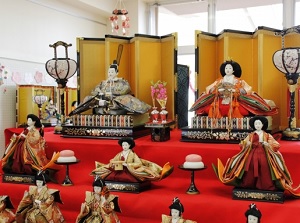
Decorated Hina Dolls
Doll Festival is March 3rd and is called Hina-matsuri in Japanese.
This is an occasion to pray for young girls' growth and happiness.
Most homes with girls display Hina-dolls in a room.
And peach blossoms, rice cake cubes, special colored and diamond-shaped rice cakes, white sake, and other items are dedicated.
In some provincial towns, there is also an event called "Nagashi-bina".
Girls float small Hina-dolls on a flowing river to wash away bad luck.
Day of the Great East Japan Earthquake (March 11)

Destroyed town by tsunami
At 14:46 on March 11, 2011, the huge earthquake occured in the Pacific Ocean around several hundred kilometers east of Honshu Island.
It was the greatest earthquake ever recorded in Japan. (Magnitude of 9.0)
Eastern half of Honshu Island including Tokyo shook violently, then enormous tsunami attacked the eastern coast of the island within an hour.
Many towns near coast, especially in Tohoku Region, were destroyed and over 18,000 people were killed by the tsunami.
Also, the tsunami destroyed a nuclear power plant in Fukushima Prefecture, and radiation damage caused.
Now, the wide area is on the road to recovery.
On this day, the whole of Japan remember the disaster and think the preparation for the coming great earthquake.
White Day (March 14)
March 14 is the "White Day" and is the only Japanese anniversary.
Men present to women in return for their Valentine's chocolates.
Of course, women hope more expensive presents than chocolates...
Vernal Equinox Day (Around March 20)
On around March 20, the lengths of day and night are equal.
In Japan, this is one of the important day from old times, so this day is a national holiday.
In a week around this day, people visit their ancestral graves and make offerings of flowers and incense.
April (4-gatsu, Shi-gatsu)
Cherry blossom season
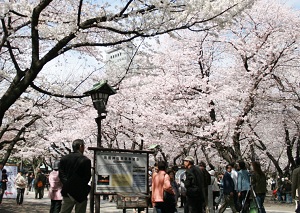
Cherry blossoms in Ueno Park of Tokyo
Japanese people feel the spring with the cherry blossom.
Cherry trees are all over the country.
They fully blossom about a week after they start to bloom, but after that all blossoms of the tree rapidly fall.
When the cherry blossoms are in full bloom, we have custom to hold a party under the bloom with family, colleagues from work, or friends.
It is called "hanami".
This season is in early April from Kanto area and to the west, and is in mid-April in Tohoku area.
Golden week
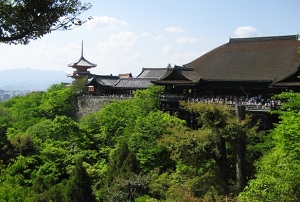
Kiyomizudera in fresh green leaves in Golden week
From the end of April to the beginning of May, there are a few national holidays and May Day.
- April 29 : Showa Day (National holiday)
- May 1 : May Day
- May 3 : Constitution Memorial Day (National holiday)
- May 4 : Green Day (National holiday)
- May 5 : Children's Day (National holiday)
In addition, there are Saturday and Sunday during this period, so we can get long consecutive holidays.
Therefore, this week is called Golden Week.
Because it has comfortable climates, many Japanese people go out or travel.
So sightseeing areas around Japan are crowded.
Showa Day (April 29)
April 29 is "Showa Day" and it is a national holiday.
This was the birthday of Showa Emperor who reiged from 1925 to 1989.
In his period, Japanese people experienced world crisis, the Pacific War (World War II), postwar reconstruction and economic growth, the oil shocks and bubble era.
May (5-gatsu, Go-gatsu)
Constitution Memorial Day (May 3)
May 3rd is "Constitution Memorial Day" and it is a national holiday.
After the War of the Pacific, the current Japanese constitution came into effect on this day in 1947.
Recently many people are arguing about whether we amend the constitution.
Green Day (May 4)
May 4 is "Green Day" and it is a national holiday from 2007.
Originally, This day was a weekday.
But, the day between two national holidays became a new national holiday by law from 1985.
And this name was given in 2007.
Children's Day (May 5)
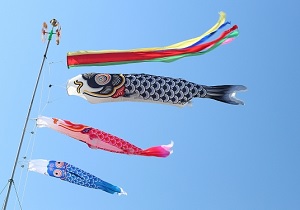
Flying Carp streamers
May 5 is Children's Day.
Originally it was called Boy's Festival and was for celebrating healthy growth of boys, but now it has become a day to celebrate all children in general.
On this day, families with boys set out Boy's Festival dolls, patterned after warriors and heroes, and fly carp streamers (Koi-nobori).
Carp have the strength to swim up waterfalls and have been taken as the symbol of success in life.
The day also features the practice from long ago of taking a bath with iris leaves which are reputed to have medicinal effect.
And it is also essential to make an offering of the traditional Japanese confections "Chimaki".
It is rice dumpling wrapped in bamboo leaves.
Rice-planting season
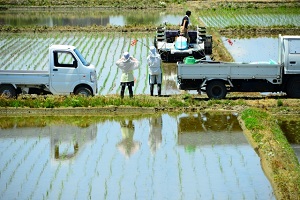
Rice-planting
Rice is the staple food of the Japanese.
Therefore, more than half of the farmland in Japan is for rice.
Rice-planting are mainly in May in Japan.
Cultivated field is filled with water like shallow pond, and rice sprouts are planted orderly.
It is the typical rural scenery in this season that you can see the wide fields of water with a lot of small green sprouts.
June (6-gatsu, Roku-gatsu)
Seasonal change of clothing
In Japan, June 1st is the day to change clothes for the new season.
School uniforms change to summer clothes, and ordinary people also change to ones.
The beginning of tsuyu
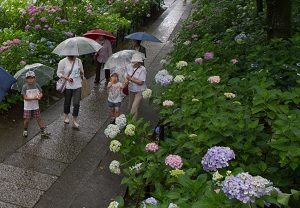
Hydrangea in tsuyu season
From mid-June, rainy season starts for about a month every year.
(In Okinawa islands it starts from mid-May.)
This season is called "tsuyu".
Rainy or cloudy days continue and we feel humid every day.
The laundry is difficult to dry, and the clothes are easy to get moldy.
The Japan Meteorological Agency declares the beginning of tsuyu by region.
July (7-gatsu, Shichi-gatsu)
Tanabata (July 7)
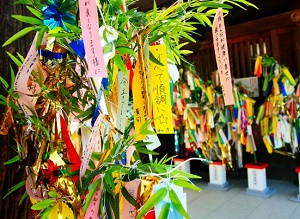
Tanabata decoration
Tanabata is the Weaver Star Festival on July 7th.
The Chinese legend, which has it that Altair (the Cowherd Star) and Vega (the Weaver Star) were split apart by the two banks of the River of Heaven (the Milky Way).
And they come together once a year on this night.
On the night of the 6th, people write their wishes or poems on strips of colored paper.
And, they hang the strips on leafy bamboo.
Then, it is displayed until the night of the 7th.
These are attractive enough to be called summer Christmas trees.
Marine Day (3rd Monday of July)
Marine Day is on the third Monday in July and is a national holiday since 1996.
Japan is a seafaring country and we thanks for the gifts from sea.
The end of tsuyu
Around mid-July, tsuyu finishes.
(In Okinawa islands it finishes in mid-June.)
One day, suddenly the sun brightly shines and it get very hot.
This is the start of midsummer in Japan.
The Japan Meteorological Agency declares the end of tsuyu by region.
August (8-gatsu, Hachi-gatsu)
Atomic bomb days and Anniversary of the end of World War II
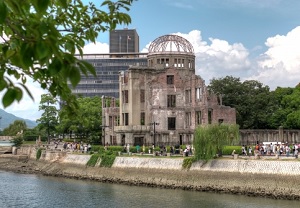
Atomic Bomb Dome in Hiroshima
Japan had battled against allied forces involving many Asian countries since 1937.
But, Japan was near the defeat in 1945.
On August 6, the city of Hiroshima was atom-bombed for the first time in human history.
And on 9th, the second atomic bomb was dropped on Nagasaki.
At last, on August 15, Japan made the unconditional surrender.
More than three million Japanese people died in this war.
On each day, memorial celemonies are held every year.
We renew the determination to hand down the memories of the wretched war with the feeling that we should never go to war again.
Obon (Bon)
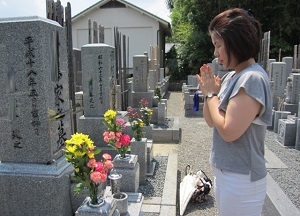
Visiting the ancestor's grave
Obon is originally Buddhist event occurring from the 13th to 16th in August to hold a memorial service to the spirits of ancestors.
As the heading character "o" in "obon" make the word polite, it is also called "Bon".
It is said that the spirits of the dead return at this time.
Fires are lit at the entrances to homes, so the spirits do not lose their way.
And, lanterns being lit inside homes.
The Buddhist home alters are tidied up, and vegetables and fruits are set out as offerings.
When bon is over, the spirits are sent on their way.
Many people receive company holidays during the Obon period and go back to their hometowns.
Since 2016, August 11 became a national holiday as the Day of Mountain.
Therefore, many people can plan a long vacation with Obon and the Day of Mountain.
For that reason, all transportations in this period are crowded.
September (9-gatsu, Ku-gatsu)
Moon viewing
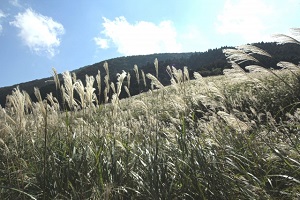
Field of silver grass in Sengokuhara of Hakone
In the Orient, there is a custom of appreciating the moon from old times.
Especially autumn is the best season.
In China and Korea, it is the big festival at the full moon night in late September.
In Japan, it is common that each home do as they like.
Traditionally dumplings, silver grass and seasonal fruits offered to the moon are set out by the window and the full moon is appreciated.
But recently only a few homes do so.
For your information, Japanese see the dark patches on the moon as a rabbit.
Respect for the Aged Day (3rd Monday of September)
The third Monday of September is a national holiday called Respect for the Aged Day.
It is a day to honor the aged, celebrate their long life, pray for their good health in the future.
On this day, regional governments and respect-for-age associations organize all kinds of events such as variety shows and they present commemorative gifts.
Volunteers make sympathy visits to old people's homes.
Autumnal Equinox Day (Around September 23)
On around September 23th, the lengths of day and night are equal.
Like Vernal Equinox Day in spring, this day is a national holiday.
In a week around this day, people visit their ancestral graves and make offerings of flowers and incense.
Rice harvest

Rice harvest
The rice planted in late spring grows and becomes golden color in early autumn.
The water is removed from the rice field, then the rice harvest is held.
The harvested rice plants are dried in the sun for a few weeks.
After that, the rice plants are threshed.
The boiled "new rice" is the most delicious in all seasons.
October (10-gatsu, Juu-gatsu)
Seasonal change of clothing
October 1st is the day to change clothes for the cold season.
School uniforms change to winter clothes, and ordinary people also change to ones.
National Sports Day (2nd Monday of October)
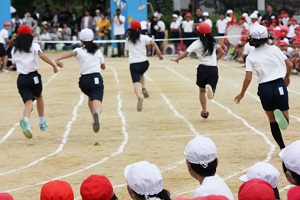
Athletic meet in an elementary school
The second Monday of October is National Sports Day and is a national holiday.
The day was originally celebrated on October 10th to commemorate the opening ceremony of the 1964 Tokyo Olympics.
But it was changed to this day by a new law in 2000.
Its purpose is to familiarize with sports and nurture physical and mental health.
So many sport events are held across the country.
Halloween (October 31)
Halloween is a popular festival in Western countries.
In Japan, it has become an event in autumn since the 1990s.
Surely, many people of young generation enjoy the event.
Some grand events are held in major theme parks and big commercial facilities.
But about half of Japanese people aren't interesting in Halloween.
So, I think this is not a national event of Japan at the current stage.
November (11-gatsu, Juu-ichi gatsu)
Culture Day (November 3)
November 3rd is a national holiday called Culture Day.
Originally, it was for observing the birthday of the Meiji Emperor, but now it is a day to love freedom and peace and to promote culture.
On this day, many cultural and art festivals held by each school and regional society.
And the government confers Cultural Order Awards on individuals who have contributed to Japanese culture.
In particular, people who have made efforts for the development of Japanese culture are presented with the Order of Cultural Merit, and they are award it directly from the Emperor.
Shichi-go-san [7-5-3] (Basically November 15)
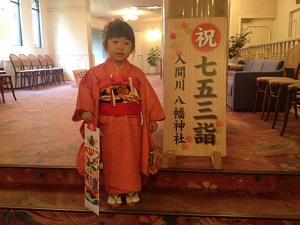
A girl visiting a shrine for Shichi-go-san
Shichi-go-san means the three numbers.
In sequence, they are 7, 5 and 3.
Because odd numbers are auspicious in Japan, the children of odd numbered years are celebrated.
Boys are celebrated at 3 and 5 years old, and girls are celebrated at 3 and 7 years old.
On this day, children dress up in gorgeous kimono, and visit a Shinto shrine with their parents.
Shichi-go-san is originally cerebreated at November 15th, but recently many families select the own good day in October or November.
Labor Thanksgiving Day (November 23)
November 23 is Labor Thanksgiving Day and a national holiday.
This is the day for the people to honor labor, celebrate manufacturing and give thanks to one another.
Autumn leaves
Autumn leaves viewing are one of the pleasures in autumn.
The best period is early November in Hokkaido and Tohoku regions and late November in the other regions in the mainland.
There are many popular spots throughout Japan.
Because a lot of tourists visit there on the holidays of November, the transportations to the spots are crowded.
December (12-gatsu, Juu-ni-gatsu)
Bonenkai
"Bonenkai" means the party for forgetting the year.
The group of members of workplace or the group of friends go to Japanese-style pub and drink together.
So, from beginning to end of December, any and every pub is full.
And, there are many drunken persons in any town at night.
Christmas Eve (December 24) and Christmas (December 25)
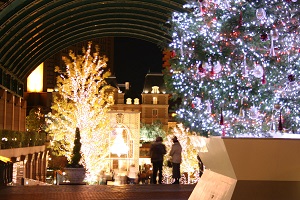
Christmas illuminations in Tokyo
Though most Japanese aren't Christians, they enjoy Christmas without faith.
They exchange presents with family and sweethearts, and enjoy their meal on Christmas Eve.
In particular, children look forward to find a gift from Santa Claus when they awake in the morning of Christmas.
On Christmas Eve, enormous numbers of beautiful Christmas cakes are bought around Japan.
The strategy of department stores and businesses, which is to stimulate consumer desire, has created this sort of Christmas culture in Japan.
In addition, Christmas is not a holiday in Japan.
Omisoka (December 31)
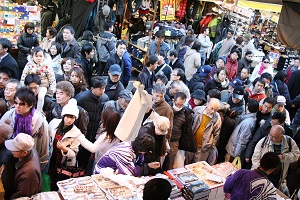
Crowded Ameyoko shopping street in Tokyo on Omisoka
The last day of the year, December 31st, is called omisoka.
To welcome the new year, general house-cleaning is completed and "Osechi" dishes are prepared in most familied by this date.
Many families go back to their hometowns, and greet the new year with a sense of togetherness.
They are accustomed to eating "year-crossing noodles" in this day.
At about midnight, large blonze bells to terminate the old year begin to be rung at many Buddhist temples.
It is called "Joya-no-kane" in Japanese.
According to Buddhist teaching, human beings have 108 worldly desires.
So, they are removed by striking the bell 108 times at the end of the year.
In major theme parks, New Year's Eve events are held all night.
And many people start to visit the temples and shrines from 0:00 of the New Year.

